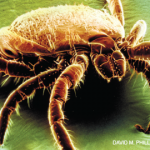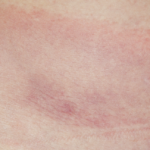The Rheumatologist’s Perspective
For those of us who practice in endemic areas, seeing and diagnosing Lyme disease should be fairly straightforward. Most patients present with either a mono- or oligoarticular large-joint synovitis that has a predilection for involving the knee. It should rarely be confused with rheumatoid arthritis. However, many patients are mistakenly under the impression that B. burgdorferi infection may be the cause of their chronic polyarticular joint achiness. In the earliest stage of Lyme disease, one may develop a flu-like illness with polyarthralgias along with the rash, but these symptoms subside within a matter of days.
One fascinating aspect of Lyme arthritis has been its evolution from being an infectious disease to becoming an autoimmune disorder in some individuals. This transition was well summarized in a recent study led by Dr. Steere, currently professor of medicine at the Harvard Medical School in Boston.6 As evidence against the persistent infection hypothesis, polymerase chain reaction and culture results of synovectomy specimens obtained following antibiotic use have been uniformly negative. In addition, relapse of infection has not been observed with the use of disease-modifying antirheumatic drugs such as methotrexate or anti–tumor necrosis factor inhibitors after antibiotic therapy.
Contrary to what might be expected with retained spirochetal antigens, T- and B-cell responses to B. burgdorferi decline to a similar degree in patients with refractory arthritis and in those with responsive arthritis. Yet, levels of inflammatory mediators in synovial fluid, such as interferon-gamma, remain high or even increase in patients with refractory arthritis during the postantibiotic period. Although these inflammatory mediators are initially important for the eradication of the spirochete, the inability to downregulate their expression in these individuals likely contributes to immune dysregulation and persistence of the arthritis.
Additional evidence in support of the autoimmunity hypothesis is the observation that specific HLA–DR alleles, particularly the DRB1*0101 or 0401 alleles, are the greatest-known genetic risk factor for developing an antibiotic refractory arthritis. Similar to other chronic inflammatory arthritides, HLA–DR molecules in antibiotic refractory Lyme arthritis are intensely expressed in inflamed synovium. Might this transformation from infectious illness to an autoimmune disorder serve as a paradigm for other inflammatory disorders?
A World of Controversy
Infection with B. burgdorferi can extend beyond the joints. Aside from inflaming heart tissues, this spirochete is also capable of finding its way to the central nervous system (CNS). Certainly this is the case for a fellow spirochete, Treponema pallidum. Back in the old days, medical students and interns were taught that the first step in establishing the diagnosis of neurosyphilis was to confirm that the patient had actually been infected with T. pallidum, since one could not have neurosyphilis without first having syphilis.



